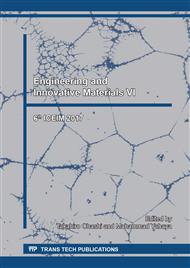p.31
p.38
p.44
p.53
p.58
p.63
p.68
p.73
p.80
Magnetic and Mechanical Properties of the Amorphous Alloys
Abstract:
It is clearly seen that the magnetic induction of the amorphous ribbon produced by conventional technology implying heating up to 1490 °С increases as the thickness of specimens increases, with this growth being especially intensive at the 100 А/m magnetic field strength. At the same time, the melt preparation supplemented by overheating contributes to the magnetic induction stabilization, i.e. magnetic induction is essentially independent of the ribbon’s thickness. It is only at high values of h that a slight increase in magnetic induction becomes evident. The fracture diameter of the free side surface is linearly increasing as the annealing temperature increases. The structure has been shown to influence magnetic and mechanical properties of the material in preparing the melt before casting.
Info:
Periodical:
Pages:
58-62
Citation:
Online since:
January 2018
Price:
Сopyright:
© 2018 Trans Tech Publications Ltd. All Rights Reserved
Share:
Citation:


